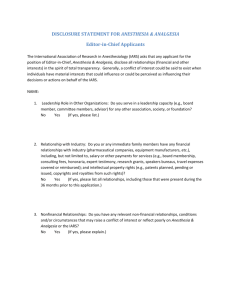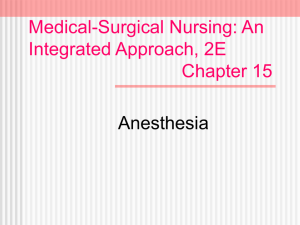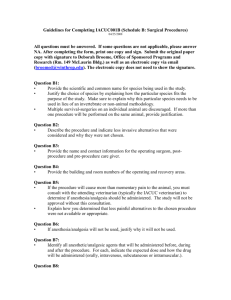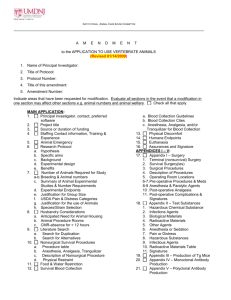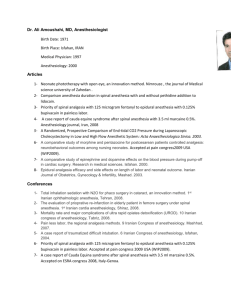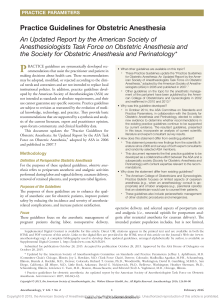translating professional “competencies” into practice Completing the professional work embodied in each EPA requires a host of competencies performed in
advertisement
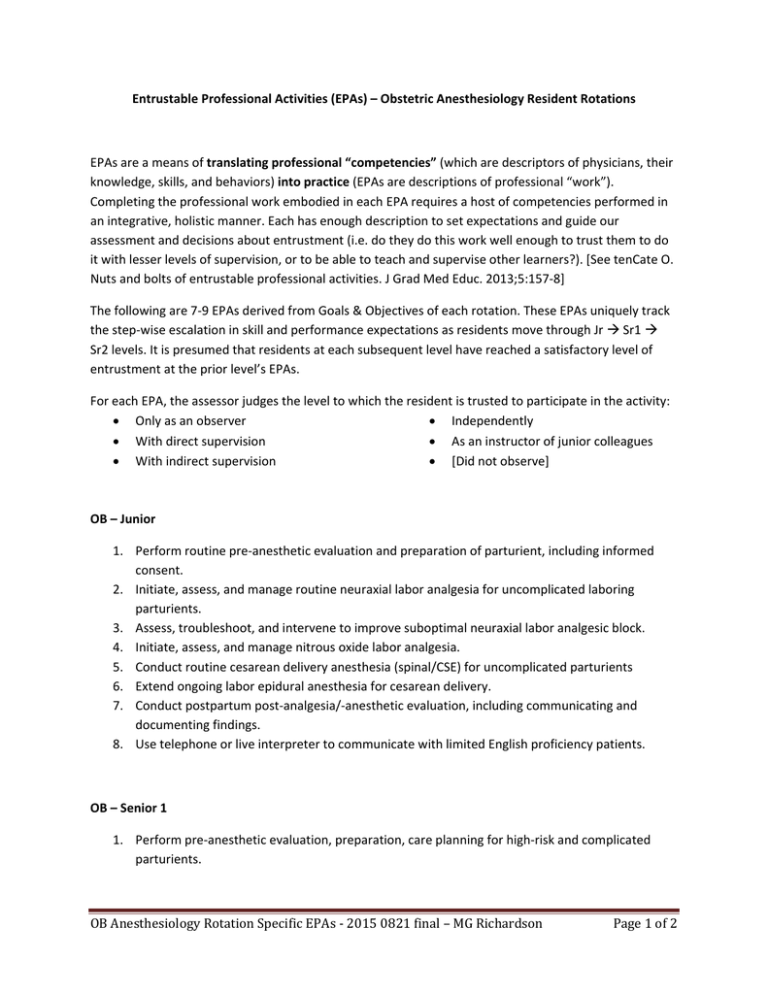
Entrustable Professional Activities (EPAs) – Obstetric Anesthesiology Resident Rotations EPAs are a means of translating professional “competencies” (which are descriptors of physicians, their knowledge, skills, and behaviors) into practice (EPAs are descriptions of professional “work”). Completing the professional work embodied in each EPA requires a host of competencies performed in an integrative, holistic manner. Each has enough description to set expectations and guide our assessment and decisions about entrustment (i.e. do they do this work well enough to trust them to do it with lesser levels of supervision, or to be able to teach and supervise other learners?). [See tenCate O. Nuts and bolts of entrustable professional activities. J Grad Med Educ. 2013;5:157‐8] The following are 7‐9 EPAs derived from Goals & Objectives of each rotation. These EPAs uniquely track the step‐wise escalation in skill and performance expectations as residents move through Jr Sr1 Sr2 levels. It is presumed that residents at each subsequent level have reached a satisfactory level of entrustment at the prior level’s EPAs. For each EPA, the assessor judges the level to which the resident is trusted to participate in the activity: Only as an observer Independently With direct supervision As an instructor of junior colleagues [Did not observe] With indirect supervision OB – Junior 1. Perform routine pre‐anesthetic evaluation and preparation of parturient, including informed consent. 2. Initiate, assess, and manage routine neuraxial labor analgesia for uncomplicated laboring parturients. 3. Assess, troubleshoot, and intervene to improve suboptimal neuraxial labor analgesic block. 4. Initiate, assess, and manage nitrous oxide labor analgesia. 5. Conduct routine cesarean delivery anesthesia (spinal/CSE) for uncomplicated parturients 6. Extend ongoing labor epidural anesthesia for cesarean delivery. 7. Conduct postpartum post‐analgesia/‐anesthetic evaluation, including communicating and documenting findings. 8. Use telephone or live interpreter to communicate with limited English proficiency patients. OB – Senior 1 1. Perform pre‐anesthetic evaluation, preparation, care planning for high‐risk and complicated parturients. OBAnesthesiologyRotationSpecificEPAs‐20150821final–MGRichardson Page1of2 2. Conduct neuraxial analgesia in parturients with medical or obstetric complications (e.g. uteroplacental insufficiency; hypertensive disease). 3. Recognize suboptimal neuraxial labor analgesia, troubleshoot and intervene intervene with a multi‐step plan for improvement in case initial interventions fail. 4. Manage and augment labor epidural anesthesia for forceps delivery, twin delivery, post‐partum tubal sterilization, or evacuation of retained products. 5. Postpartum hemorrhage (volume resuscitation, transfusion, conduct of anesthesia). 6. Manage accidental dural puncture (“wet tap”), including disclosure, conduct of continuous intrathecal analgesia, postpartum follow‐up, and management of spinal headache. 7. Maintain current knowledge of all patients on service, collaborating with inter‐professional maternal care team members, and prioritizing and delegating anesthesia care. OB – Senior 2 1. Conduct anesthesia/analgesia in parturients with challenging medical or obstetric complications (e.g. uteroplacental insufficiency; hypertensive disease; coagulation disorders; heart disease). 2. Conduct anesthesia/analgesia in technically challenging parturients (e.g. morbid obesity; scoliosis; advanced labor/lateral position, cultural/linguistic barriers) . 3. Assess, troubleshoot, and intervene effectively to improve poorly functioning neuraxial labor blocks. 4. Conduct anesthesia for special circumstances (external cephalic version, vaginal twin delivery, post‐partum hemorrhage, perineal birth trauma). 5. Manage accidental dural puncture (“wet tap”), including disclosure, conduct of continuous intrathecal analgesia, postpartum follow‐up, and management of spinal headache. 6. Manage post‐partum complications, e.g. neurologic deficits, back pain, spinal headache (including performance of epidural blood patch). 7. Conduct anesthesia for urgent and stat cesarean delivery, including rapid epidural top‐up, general anesthesia, and “rapid sequence spinal”. 8. Maintain current knowledge of all patients on service, collaborating with inter‐professional .maternal care team members, and prioritizing and delegating anesthesia care, while remaining continually aware of staffing limitations. 9. Anticipate and plan for potential obstetric emergencies and complications based on knowledge of current patients on the census and their comorbidities. OBAnesthesiologyRotationSpecificEPAs‐20150821final–MGRichardson Page2of2
